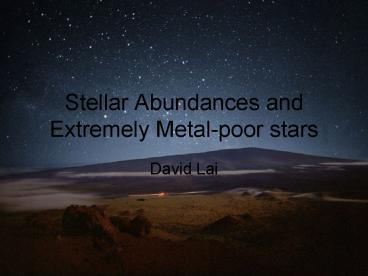Stellar Abundances and Extremely Metalpoor stars PowerPoint PPT Presentation
1 / 23
Title: Stellar Abundances and Extremely Metalpoor stars
1
Stellar Abundances and Extremely Metal-poor stars
- David Lai
2
Outline
- Part I A brief introduction to stellar spectra
and measuring abundances - Part II A brief introduction to extremely
metal-poor (EMP) stars
3
What are we measuring?
- Absorption line strength
- Atomic physics
- Excitation potential and oscillator strength
- Radiation damping
- The effects of the atmosphere, surface gravity
and temperature - Thermal broadening
- Microturbulence
- Pressure broadening (collisional broadening)
- How much of the element is present!
4
Line measurement
- Take a spectrum
- Measure the equivalent width of a transitions,
i.e. the strength of the line - Curve of growth behavior of equivalent width vs.
number of atoms
5
Equivalent Width
6
EW to abundance
- Atmospheric parameters
- Surface gravity
- Effective temperature
- Microturbulent velocity
- Metallicity
- Model atmospheres
- Use a LTE stellar analysis code, e.g. MOOG or
SME, for equivalent width analysis or spectrum
synthesis.
7
Examples of synthesis
8
Issues
- Determination of stellar parameters
- Color - Effective temperature relations
- Isochrones
- Ionization balance (with the caveat mentioned
below) - Uncertainties in the atomic and molecular data
- NLTE effects
9
Part II
10
Why study EMP stars?
- Describe the nature of Population III objects
- and maybe find one
- Constrain models of massive SNII
- Trace early Galactic chemical evolution
- Nuclear physics of r- and s-process
11
How do you find them?
12
From low to high resolution, the search for EMP
stars
- Objective prism surveys,
- Bond 1980
- The Beers, Preston Schectman HK survey
- HES survey
- Photometry
- Spectra
13
What do you expect to see?
14
Dependence on Metallicity and Mass
Heger et al. 2003
15
Initial mass and remnant
Heger Woosley 2002
16
The IMF
- Cooling and mass loss(or the lack thereof)
- A first generation of supermassive stars (e.g.
Abel et al. 2002) - IMF biased towards higher mass objects
- Possible bimodal IMF
17
Origin of the light elements (Z lt 30)
- Big bang nucleosynthesis
- Supernovae II
- Pair instability supernovae
- AGB mass transfer
- Mixing
18
The s-Process
- Slow neutron capture relative to the ?-decay
timescale - Mass transfer from low mass AGB stars
- Up to 209Bi
- Helium burning in massive stars
- Not much contribution to A gt 90
19
Johnson Bolte 2004
20
The r-Process
- Rapid neutron capture relative to the ?-decay
timescale - Neutrino wind from SNe II
- Merging neutron stars
- Different sites for lighter, Z lt 56, elements?
21
Sneden et al. 2003
22
Galactic Chemical Evolution
- Environment and the role of supernovae
- McWilliam et al. 1995
- Cayrel et al. 2004
Lai et al. 2004
23
The present and future
- BPS follow up
- CS 22892-052 and CS 31082-001
- HES follow up
- HE 1327-2326, Fe/H -5.4
- HE 0107-5240, Fe/H -5.3
- Low resolution confirmation, and high resolution
detailed analysis - Sloan Digital Sky Survey
- Compare to model yields, SNII, PISN, AGB
Supernove, etc.
24
How can we learn about Population III stars?
Number of sightings of the Loch Ness Monster
gt250
We have pictures! ?
0
Number of sightings of Pop III stars
Slide by Jennifer Johnson

